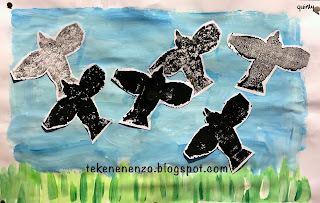You need:
- white drawings sheets A3 size
- white and blue tempera paint
- paper with stone print
- white round paper
- camera
- bowler hat and black coat
- brushes
- small dishes
- sponges
René Magritte
Rene Magritte is born in 1898 in Belgium. When Magritte is 13 years old, his mother commits suicide. She jumps in the river Samber and is found with her dress covering her face. This image has been suggested as the source of several paintings from Magritte: people hiding their faces with several objects.
In 1924 Magritte became friends with members of a surrealism group in Brussels: André Breton, Joan Miró and Salvador Dalí. These artists influence Magritte's work. In the end Magritte became famous with surrealistic paintings.
Magritte gave his paintings a realistic effect of surrealism. He painted simple objects, like a shoe, an apple, a pipe or a tree. Magritte took these things out of their ordinary environment and placed them in a special surrounding.
One of Magritte's most famous works is "La Trahison des Images" (The Treachery of Images). This is a very realistic painting from a pipe, with the text: Ceci n'est pas une pipe (This is not a pipe). The painting is not a pipe, but rather an image of a pipe. As Magritte himself commented: "The famous pipe. How people reproached me for it! And yet, could you stuff my pipe? No, it's just a representation, is it not? So if I had written on my picture 'This is a pipe,' I'd have been lying!"
By putting us constantly on the wrong track, Magritte forces us to think about art. Magritte thought it the task of an artist to place reality in a different context.
Look at the artwork
Discuss the painting The son of man. What do you see? What does the man wear? What's on his head? Why can he see little? Can he see nothing of can he peek at the edge of the apple? What's wrong with his left arm? (his arm appears to bend backwards at the elbow). What do you see at the background? What does the sky look like?
How do you make this artwork?
Take photographs of the students wearing a bowler hat and a dark coat; arms hanging beside the body. Students paint their sheet blue and let it dry. Cut a wall out of stoneprint paper and stick it on the blue sky. Stamp white spots on the artwork using a sponge. Let dry againg. Cut the photo neatly along the edges and paste it on the blue sheet in front of the stoneprint paper. Draw a piece of fruit on the circle sheet and show color transitions, just like real fruit. Paste it on the face.
Both artworks are made by students of grade 1















